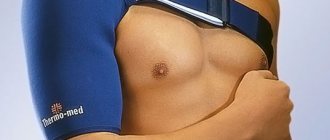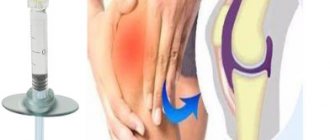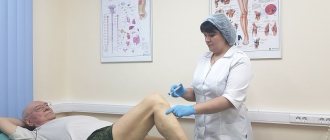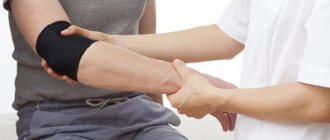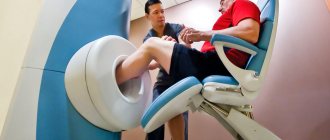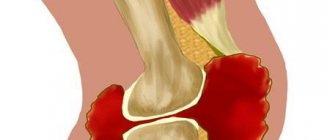The elbow joint has a complex structure and combines three paired articulations of the humerus, ulna and radius. These three joints are united by one articular capsule. Accordingly, either one of the areas or all of them can be affected, which determines the severity of the manifestations.
Injection into the elbow joint
The main pathologies of the elbow joint and surrounding tissues include:
- arthritis (rheumatoid and psoriatic);
- post-traumatic osteoarthritis;
- myositis ossificans (ossification in the muscles after a peri- or intra-articular fracture);
- contractures (limited mobility due to pathological changes in tissue) due to scleroderma or polymyositis;
- “tennis elbow” (medial and lateral epicondylitis) – due to constant stereotypical movements with joint extension and rotation of the forearm, tendon pathology develops at the point of muscle attachment on the inner or outer side of the elbow;
- elbow bursitis due to rheumatoid arthritis and gout.
Osteoarthritis of the elbow joint is a fairly rare problem, while epicondylitis is one of the most common pathologies of the upper extremities.
An injection into the elbow joint or periarticular tissue is an effective method of combating the above diseases.
Injections into the elbow joint and medications used
As part of complex therapy, the following drugs are administered intra-articularly:
- Hormonal agents have powerful anti-inflammatory and analgesic effects and are necessary for urgent relief of pain and inflammation. For example, injections for elbow bursitis help stop the accumulation of inflammatory fluid.
- Chondroprotectors - nourish and improve metabolism in the cartilage of the elbow joint.
- Hyaluronic acid is a synovial fluid prosthesis that helps lubricate articular cartilage and reduces friction.
Diprospan is often administered for therapeutic purposes. An injection into the elbow joint of this medicine, a glucocorticosteroid, is famous for its long-lasting and rapid action. Side effects are minimal. This medication is also used for therapeutic blockades in the treatment of the spine in case of severe pain. The pain goes away almost immediately. For Diprospan injection into the elbow joint, the price at the Stoparthrosis clinic is indicated on the website. All injections have different costs.
How does novocaine blockade work?
The action of the blockade is based on stopping the innervation of the affected area using the anesthetic novocaine. Its active effect is aimed primarily at the nervous system.
The mechanism of action of novocaine during blockades is as follows:
- After injecting the drug into the source of pain, the anesthetic envelops the nerve endings and blocks the transmission of impulses along the nerve fibers.
- By blocking the receptors, the innervation of the affected area is switched off, causing pain to disappear.
Pain relief occurs in 3 stages. At first, the pain may intensify due to irritation of the nerve endings by the needle. In the second stage, the pain gradually decreases and by the third stage it completely disappears.
Novocaine accumulates in nerve tissues, preventing pain impulses from spreading along nerve fibers
Novocaine accumulates in nerve tissues, preventing pain impulses from spreading along nerve fibers
After the novocaine blockade, the patient feels significant relief. Not only severe pain disappears, but also spasm in muscle tissue.
Treatment of pain using blockade is accompanied by a wide therapeutic effect:
- inflammation and swelling decreases;
- metabolic processes in nerve fibers improve;
- the permeability of the walls of blood vessels decreases, their tone increases;
- spasm of smooth muscles decreases.
The analgesic effect of novocaine blockade occurs within 5-10 minutes. After administration of the drug, it lasts for 40-60 minutes. Then the pain may return, but not with such force. To achieve the maximum therapeutic effect, medical blockades are carried out in courses. 2-15 injections are required, depending on the intensity of the pain syndrome and the disease that caused it.
Novocaine blockade for pain is used not only as an anesthetic. This is an effective method for relieving other neurological symptoms: numbness, sensitivity, burning, tingling.
The procedure is invasive and difficult to perform. It must be performed by a qualified medical specialist - a vertebrologist or neurologist with additional qualifications in the field of local injection therapy. Doctors from the SmartMed clinic have extensive experience in conducting novocaine blockades, guaranteeing the achievement of the desired therapeutic result and the absence of side effects.
Indications and contraindications
Indications for injections include inflammatory processes in the articular and periarticular area, synovial bursa, and degenerative processes. Also, local administration of drugs is prescribed for fluid accumulation. An injection for bursitis of the elbow joint is not recommended during periods of acute infection, during pregnancy, with skin problems in the elbow area and cancer. Before therapy, consultation with a doctor is important.
Do you need to get an injection in the elbow joint with Diprospan or another? Contact the Stoparthrosis clinic. It has modern equipment and experienced specialists. Here, all treatment and diagnostic procedures are carried out by qualified doctors. Get diagnosed and treated, return to a full life!
Author of the article:
Litvinenko Andrey Sergeevich
Orthopedist
Make an appointment
Recent publications by the author:
- Chondroprotectors 3rd generation
- Hyaluronic acid: benefits
- Gialgan and analogues
- Fermatron for the knee joint
Blockades for epicondylitis
Epicondylitis of the elbow joint is a degenerative-inflammatory tissue pathology that develops at the sites of tendon attachment to the internal and external epicondyles of the humerus. The disease can be lateral, with clearly localized pain along the outer surface of the elbow, and medial, in which pain occurs on the inner area of the joint. Blockade for epicondylitis of the elbow joint is used for both acute and chronic inflammation of the elbow.
After treating the skin with antiseptics, the doctor inserts the needle until it comes into contact with the bone, and then moves it back a couple of millimeters. For one blockade, about 6 ml of medicinal solution is used. If glucocorticosteroids are used, then after 10 days the procedure is repeated. After periarticular administration of any drug, immobilization of the elbow joint is necessary. For fixation, semi-rigid orthoses or elastic bandages are used.
It is considered more difficult to carry out a blockade with medial epicondylitis, because the ulnar nerve is located near the epicondyle of the same name. The procedure is performed by an orthopedic surgeon under fluoroscopic guidance.
Our doctors
- LITVINENKO Andrey Sergeevich
Traumatologist orthopedist Sports medicine doctor Experience: 19 yearsSign up
- SKRYPOVA Irina Viktorovna
Physiotherapist rehabilitator Experience: 20 yearsSign up
- MOISEENKO Alexey Yurievich
Traumatologist orthopedist Sports medicine doctor Experience: 17 yearsSign up
- KHOLIKOV Timur Vyacheslavovich
Traumatologist orthopedist Sports medicine doctor Experience: 19 yearsSign up
What to do if your arm hurts after the blockade?
Please note that blocking the thumb, cubital canal, and other areas can only temporarily relieve symptoms and swelling. To completely eliminate the problem, you need a complex. When carrying out the procedure, be sure to consult with your doctor, clarify what the treatment plan is, how many manipulations will be needed, what signs will disappear completely, and what else is worth fighting.
If severe discomfort appears, the condition worsens, or there is a suspicion that the blockade of the right or left arm was not completed completely, call the doctor immediately.
The cost of pain relief varies and depends on the selected pharmaceutical drugs, their concentration, and the duration of the therapeutic course. This is not just a method of pain relief. This is a proven technology that relieves inflammation, eliminates tissue swelling and the symptom of pain, which can bother you both at rest and during movement and other physical activity.
If the treating neurologist recommended the above-mentioned technique, then there is no doubt about its necessity. It is noteworthy that this is a safe method of recovery not only for the upper extremities, but also for the spine, shoulder joint, piriformis muscle, tibial and sciatic nerves, as well as hip joints and knees.
| Endoscopic treatment of carpal tunnel syndrome | To the list of articles |
Why do they contact us?
- No queues
No need to wait, we work by appointment
- All in one day
Doctor's appointment, diagnosis and treatment on the day of treatment
- Let's relieve the pain
We will help you relieve pain in just 1-2 visits to us
- We guarantee
Professional approach, affordable prices and quality
- Doctor's appointment 0 RUB!
During course treatment all consultations are free
- Three treatment options
We will select several options and offer optimal treatment
Complications
Even preliminary testing of patients to identify individual intolerance to drugs does not help to avoid the development of allergic reactions. The most dangerous systemic side effects - anaphylactic shock and Quincke's edema - occur rarely. In such cases, medical personnel will quickly provide assistance. Local allergic reactions such as urticaria develop more often. The skin swells, turns red, and small rashes form. To eliminate such side effects, the use of antihistamines is sufficient. When carrying out drug blockades, the following complications occur in 0.5% of cases:
- hematomas caused by mechanical damage to the epidermis and subcutaneous structures with an injection needle;
- an infection caused by the penetration of pathogenic bacteria into the joint cavity or ligamentous-tendon apparatus.
Such complications can develop even when a therapeutic blockade is performed by an experienced doctor. The consequences will be more serious if the single dose is incorrectly calculated or the drug is chosen. This leads to exacerbation of symptoms, progression of the inflammatory or degenerative process, and toxic effects of drugs on internal organs. Therefore, you cannot trust a specialist with insufficient experience to carry out the procedure.
Features of blockades
- All interventional procedures are carried out under the control of a portable X-ray system (C-arm) or ultrasound, in some cases dual control is used;
- All procedures are performed under local anesthesia (only in rare cases is the use of general anesthesia necessary), so patients do not require hospitalization to perform the block;
- All procedures are carried out in a specially prepared operating room, under sterile conditions, with monitoring of the patient’s vital functions to ensure maximum safety;
- After the procedure, the patient has the opportunity to rest in a specialized ward on a chair or bed under the supervision of a nurse and doctor;
Medicines used
Blockade is not only pain relief, it is a method of complex treatment of the problem, so a combination of several drugs is used for it.
- Anesthetic is the main component of the blockade (lidocaine, ropivacaine and other local anesthetics)
- NSAIDs (non-steroidal anti-inflammatory drugs) - reduce inflammatory activity, reduce swelling and pain
- glucocorticoid hormones - just like NSAIDs, have an anti-inflammatory effect, but more powerful, and are also effective for allergic inflammation
- auxiliary products (vitamins, hyaluronic acid preparations, etc.)
Do blockades treat only pain or the cause of pain?
The answer to this question depends on the type of lesion. In cases where pain is caused by muscle spasm and nerve compression (dorsalgia, headache due to osteochondrosis, etc.), the introduction of an anesthetic helps relax the muscle, improve blood supply and tissue trophism, and reduce swelling. Thus, the cause of pain is eliminated, and the problem may not bother the patient for a long time.
If we are talking about arthrosis of the joint, destruction of cartilage, or persistent damage as a result of injury, the blockade will not lead to a reversal of the disease. The administration of an anesthetic will only bring temporary relief. Radiofrequency dereception and neurolytic techniques can prolong this effect for a long time. In some cases, when pain is the main symptom of the disease, the main cause of limited limb function and deterioration in quality of life, its elimination significantly improves the patient’s well-being and allows delaying the need for more radical, complex and risky treatment. At the same time, during the blockade, medications are administered that affect the cause of the disease (steroidal and non-steroidal anti-inflammatory drugs, antibiotics). The substances act directly at the injection site, which contributes to more effective treatment and minimization of side effects.
Indications
Contraindications
Indications for the blockade are varied and are determined by the doctor in each individual case. Most often, these are diseases in which pain persists for a long time and is not effectively relieved by taking tablet analgesics:
- lower back pain due to damage to the sacroiliac joint
- radiculopathy (compression and irritation of the sensory roots of the spinal nerves)
- non-inflammatory joint lesions - arthrosis
- inflammatory joint lesions - arthritis
- myofascial syndrome (muscle spasm)
- tunnel syndrome (compression of a nerve by a tendon or muscle)
- facet syndrome (arthrosis of the facet joints)
- pain or spasm after a stroke
- individual intolerance to the administered substance (allergy to the drugs used)
- severe general condition
- psychiatric illnesses
- bleeding disorders
- children under 12 years old
- infectious inflammation at the site of the proposed blockade
- cicatricial deformation of the area of the proposed blockade
Celiac plexus block
With this type of blockade, the medicine is injected into the solar plexus area. The injection is done under the control of an X-ray machine or ultrasound.
The procedure is effective for:
- chronic pancreatitis, pancreatic necrosis;
- abdominal adhesions;
- Crohn's disease;
- tumors of the abdominal organs;
- ineffectiveness of painkillers.
You should prepare for the blockade in advance. A few days before the procedure, the doctor at our clinic recommends stopping taking anticoagulants and diuretics and adjusting the dose of glucose-lowering medications. The patient is placed on his stomach with a bolster or pillow. First, the doctor anesthetizes the soft tissue at the injection site. Then, under X-ray control, a special long needle is inserted. Through it, a local anesthetic or a drug that destroys nerve cells is supplied to the solar plexus. The patient feels warmth in the abdomen and a decrease in pain. After the procedure, observation is required in our hospital for 24 hours.



